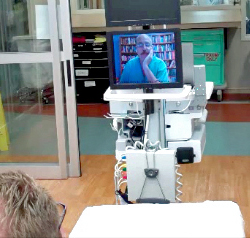Telestroke comes to Mercy

When stroke symptoms occur, every second counts. St. Joseph’s Mercy is doing its part to save those precious seconds with the implementation of the Mercy Telestroke Program.
Telestroke is a time-saving system designed to get stroke patients in front of a board-certified neurologist faster than ever before. It is possible through a partnership with NeuroCall, a Miami-based provider of Emergency Neurological coverage. The NeuroCall physicians assigned are board-certified in Arkansas and credentialed at St. Joseph’s Mercy.
This service is in addition to the neurological services currently available at St. Joseph’s Mercy. Since implementing the system on Sept. 1 it has been used several times, including successfully giving clot-busting drug t-PA to a patient.
“Our emergency room physicians will have access to a board-certified neurologist at all times of the day or night,” said St. Joseph’s Mercy President Tim Johnsen. “We feel this is going to be an excellent service for us in Hot Springs.”
There are other teleneurological programs in Arkansas, but they have not previously reached Garland, Hot Spring, Montgomery, Pike, Hempstead and Nevada counties. In addition, St. Joseph’s Mercy provides a closer destination for stroke patients in western Saline County and southern Perry and Yell counties. Hot Spring (10th), Hempstead (13th), Perry (18th), Yell (20th) and Montgomery (22nd) all rank higher than the state average in stroke mortality rates, according to the Arkansas Department of Health.
Arkansas is first nationally with 58.8 deaths per 100,000, according to the Centers for Disease Control and Prevention. Arkansas’ stroke mortality rate is 1.4 times the national average with nearly 1,900 Arkansans dying from stroke each year. A CDC study determined that fewer than 18 percent of Arkansans were aware of all the correct symptoms of a stroke and the need to call 911. These symptoms are sudden and include:
Weakness or numbness of the face, arm or leg, especially on one side of the body;Difficulty speaking or understanding;Problems with vision such as dimness or loss of vision in one or both eyes;Dizziness or problems with balance or coordination (disequilibrium);Problems with walking;And severe headaches with no apparent cause.
Person’s experiencing these symptoms should call 9-1-1 immediately. The longer a person’s brain is denied oxygen and glucose as a result of a blood clot or other blockage, the less chance the person will recover.
“Together with Mercy, NeuroCall is fundamentally changing the dynamics of healthcare delivery. We’ve successfully merged our specialist physicians with advanced communications and medical technology, such as the eICU patient management system, to reach more patients and save more lives in ways that were not possible just a few short years ago,” said Dr. Ricardo Garcia-Rivera, CEO and medical director at NeuroCall.
“We want to provide high tech stroke care for every patient who presents at any Mercy E.D
A neurologist can examine the patient to determine whether Intravenous t-PA (Tissue Plasminogen Activator), which can lessen, or even reverse, the damage caused during a stroke, should be given. If so, it must be done within the first three hours of the onset of symptoms.
“The data’s clear that this kind of physical exam is equivalent to a bedside evaluation by a physician. You get this service provided within 15 minutes of a phone call. That’s something most places can’t get,” said Dr Chris Veremakis, medical director at the Mercy Center for Innovative Care in St. Louis.
When a patient is brought to the Emergency Department with stroke symptoms, ED physicians need to determine if that person is a candidate for acute stroke therapy. Within 15 minutes a NeuroCall physician is on the phone with the emergency department doctor to see if a video consultation is in order.
During this time, the patient is sent for a CT scan (X-ray computer tomography) and blood is drawn for lab tests. A video cart system is wheeled into the patient’s room and the physician appears on the video monitor within minutes. The physician evaluates the patient with the assistance of a doctor or nurse.
The high-resolution camera system is powerful enough that the physician can check for symptoms such as pupil dilation by zooming in as the nurse holds the eyelid open. The physician can speak directly to the patient, family members, doctors and nurses. They can also enter notes and orders in the electronic health record, just like they were at the bedside.
“The NeuroCall neurologists have had training in Mercy’s electronic health record. They have the ability to immediately view all of the patient’s pertinent laboratory results, X-ray results and past medical history just as if they were standing at the patient’s bedside,” said Dr. Douglas Ross, medical director of the St. Joseph’s Mercy Emergency Department.
St. Joseph’s Mercy is a not-for-profit, faith-based health facility with 27 medical clinics serving the healthcare needs of Hot Springs and its surrounding communities since 1888 as the region’s most preferred provider of health care services including cardiac, cancer and women’s.
Supplemental MaterialsDownload Media Release PDFStroke Facts and Statistics